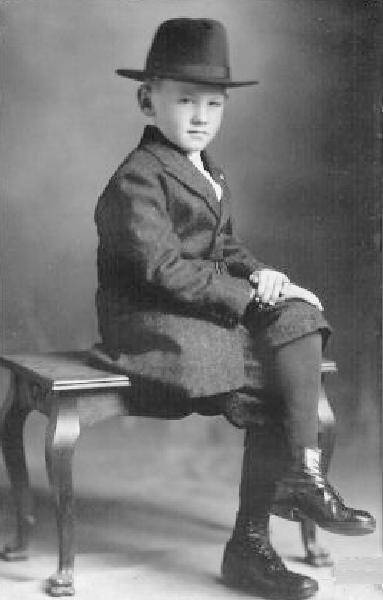
United States Boys' Hat Styles: Fedoras

Figure 1.--This American boy wears a high-crown fedora, probably in the 1920s. We at first thoughtbthatbit was a fedora, but as our understanding of hats has increased, we now know that it is a fedora. Motice that the side is not pinched--the primary difference between a fedora and homberg. It looks like he is wearing a knee pants suit, but I think they are knickers. It was much more common at the time for boys to wear flat caps, even with suits.
|
|
The fedora is a soft felt hat with a relatively narrow brim. It is less formal than the top hat and homberg which it resembles. The crown is creased lengthwise and pinched in the front on both sides--the center dent. The pinch is the major destinguishing feature separaring fedoras and hombergs. There were various styles of fdora, noemally involving variayions in the width of the brim and how it was worn and the height and pincing of the crown. Similar hats with a C-crown (with an indentation for the head in the top of the crown) are occasionally called fedoras. The term fedora began to be used in the 1890s, although few boys wore them at the time. The fedora came into use as an upper-class clothing accessory. Hats that resemble the soft felt version are often called fedoras even if they are made of straw or twill. We note some boys in the first half of the 20th century. They seem especilly common during the 1940s and 50s. They were a formal style and boys normally wore them when dressing up in suits. Hats were still commonly worn at the time. Today we tend to see those hats as rather old fashioned and worn only by men. But at the time teenagers and even occassionlly pre-teens wore them. They were more common than hombergs. These portraits look a little strange to us as boys in the first half of the 20th century tended to wear juvenile styles that set them off from adults while the fedora was seen as an adult-style. Interestingly, the fedora became the iconic headwear of Al Capone era gangsters. Even so mothers bought them for their sons.
Construction
The fedora is a soft felt hat with a relatively narrow brim. The crown is creased lengthwise and pinched in the front on both sides--the center dent. The pinch is the major destinguishing feature separaring fedoras and hombergs.
Styles
There were various styles of fedora, noemally involving variayions in the width of the brim and how it was worn and the height and pincing of the crown. Similar hats with a C-crown (with an indentation for the head in the top of the crown) are occasionally called fedoras.
The term fedora began to be used in the 1890s, although few boys wore them at the time. We note some boys in the first half of the 20th century. These portraits look a little strange to us as boys in the first half of the 20th century tended to wear juvenile styles that set them off from adults while the fedora was seen as an adult-style. A good example is an unidentified family in the 1910s. We are not entirely sure these would have been called a fedora, but it is very similar. We see more fedors after World war I in the 1920s. Some Americans in the 1920s and 30s saw the homberg as gangter hat--the Godfather hat. These hats tend to have an especially wide brim with the brim more sharply turned up at the sides. This may be more of a Hollywood style than an actual gangster hat. Our initial assessment is that these hats were most commonly worn by boys in the 1940s and 50s. This needs to be confirmed. We see many examples in the photographic record. The fedors continue to be worn with suits.
Conventions
They were a formal style and boys normally wore them when dressing up in suits. Hats were still commonly worn at the time. Today we tend to see those hats as rather old fashioned and worn only by men. But at the time teenagers and even occassionlly pre-teens wore them. They were more common than hombergs.
Social Class
The fedora came into use as an upper-class clothing accessory. It gradually became more widespread. It became the iconic headweafr of Al Capone era gangters. This does not appear to have affected its popularity with general public. And mothers even began buying them for schoo age boys. In this case we primarily see middle class boys wearing them, often families moving out to the suburbs. And almost always it was boys wearing long pats suits, in parr asocial clss indicator.
Material
Hats that resemble the soft felt version are often called fedoras even if they are made of straw or twill.
The fedora is generally seen as less formal than homberg which it resembles.
HBC

Navigate the Boys' Historical Clothing Web Site:
[Return to the Main U.S. hat style page]
[Return to the Main U.S. country headwear page]
[Return to the Main classic sailor hat country page]
[Introduction]
[Activities]
[Biographies]
[Chronology]
[Clothing styles]
[Countries]
[Bibliographies]
[Contributions]
[FAQs]
[Glossary]
[Images]
[Links]
[Registration]
[Tools]
[Boys' Clothing Home]
Created: 4:37 AM 1/12/2008
Last updated: 2:53 PM 7/28/2017



